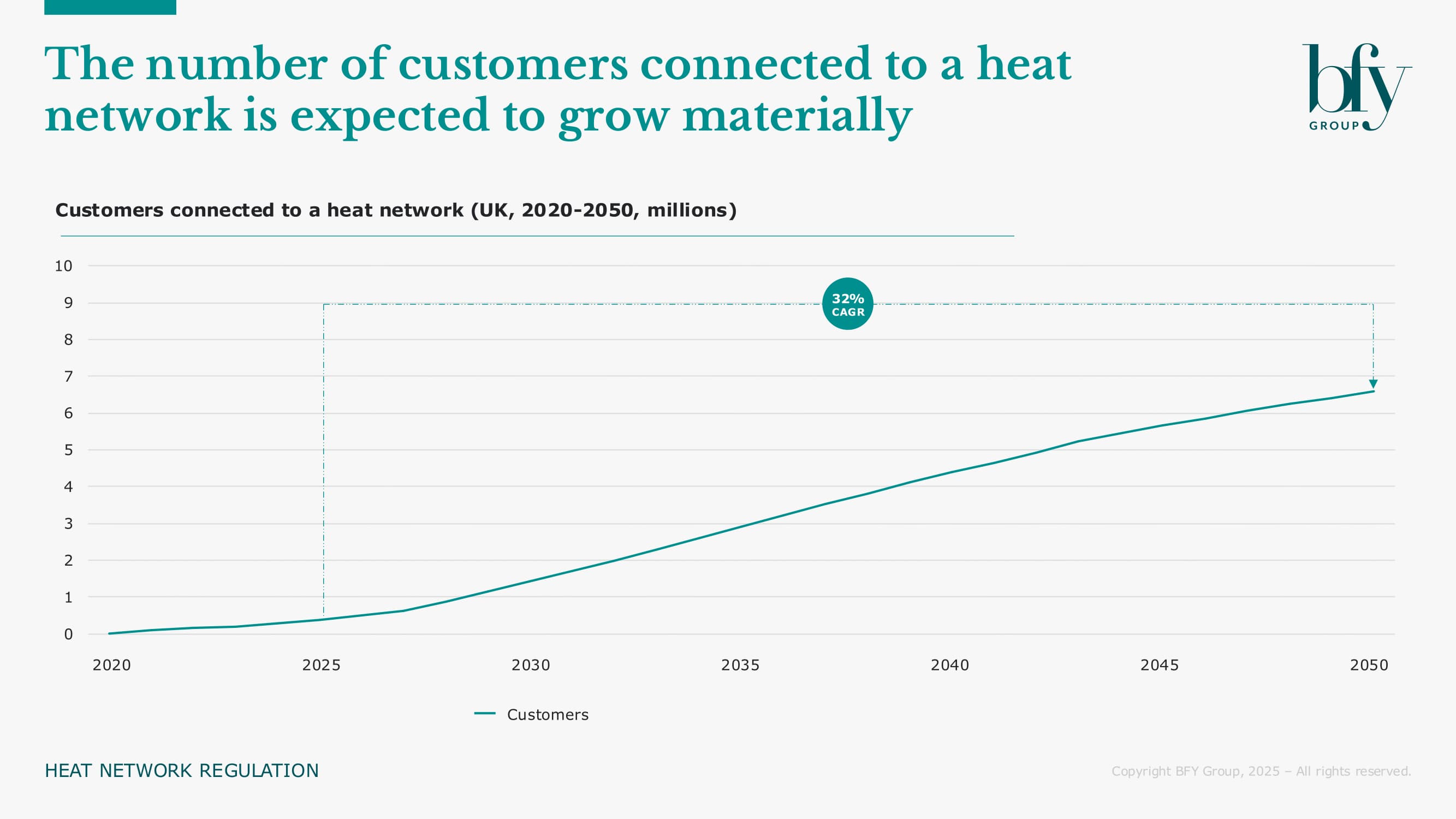In January 2026, the UK heat network sector faces a huge transformation.
As Ofgem takes regulatory control, suppliers face a stark choice: adapt quickly to thrive in a growing market or risk business failure under unprecedented scrutiny. With less than nine months to prepare, the clock is ticking - and many suppliers remain dangerously unprepared.
An estimated 3% of customers are connected to a heat network in the UK today, but there’s an ambition for that to grow to as much as 20% by 2050. The first step on the critical path to delivering this is implementing changes that place the sector under Ofgem regulation.
I know first-hand the scrutiny Ofgem regulation places on suppliers. The bar for demonstrating compliance is high. Many in the heat networks sector aren’t used to this level of oversight and are unprepared for what is coming – all in the context of a market where many have spent years sitting on unresolved problems.
The introduction of market-wide statutory regulation presents both an opportunity and a risk for heat network suppliers. Those who can get it right will stand to win from the coming growth in the market. Those who get it wrong will find themselves exposed, and eventually, risk exiting the market.
This blog explores what the changes are and why they matter. Next week, we’ll share our thoughts on what those in the sector should be doing right now to prepare.

The Current Landscape
Officially there are around 500k customers living and working on heat networks today. This is a large under-estimate however, and the true number of heat network customers today is more likely to be at least 900k, spread across as many as 25k different networks. This reflects a wide variance in the size of different heat networks, ranging from very large projects like the Queen Elizabeth II Olympic Park system, with more than 2800 connected customers, to individual buildings of sub-divided flats, supplied by one central heating system in the basement. To illustrate: there are nearly 600 registered heat networks in Westminster alone.
As you’d expect, there’s a wide range of quality and customer experience across these sites. The best in class reliably deliver affordable heat and hot water with excellent customer service. The worst are often old, under-invested, unreliable and expensive, with operators who do little to help those who rely on them. And for those unfortunate customers who do rely on them, the resolution of issues has historically been at the whim of the supplier, with little or no route to independent recourse.
Investors with a desire to see the market grow have therefore found themselves in the odd position of demanding regulation, knowing this will drive out poor practice, raise standards, and provide the foundation for growth.
Several have registered their networks with Heat Trust, the sectors’ voluntary regulator who seeks to mimic Ofgem’s regulation of the wider energy market as closely as possible. As a former Managing Director of Heat Trust, I can say with confidence that the scheme makes a genuine difference to the people living and working on the networks it covers and, in the process, helps those heat network suppliers get ‘Ofgem ready’.
Regulatory Changes on the Horizon
Fortunately, government have sought to act and from January 2026 the sector will move under Ofgem jurisdiction. The detail of the new regulations are still being finalised but will include:
- Obligations to charge customers ‘fairly’, though not extending to a price cap;
- New technical standards for the design and operation of networks;
- Specific support for customers in vulnerable circumstances;
- Limits to the power of disconnection;
- Specific rules related to the provision and use of pre-payment meters;
- Requirements to take steps to identify and support those customers self-disconnecting;
- Specific requirements around complaints handling, complementing recently implemented changes to establish an independent Ombudsman;
- New requirements on billing transparency, including specific information which bills will need to provide and limits to suppliers’ ability to ‘back bill’;
- Principles designed to improve security of supply;
- Step in measures, providing for back stop support in the event of supplier failure; and,
- The introduction of Principles Based Regulation, i.e. an outcomes based obligation to treat customers fairly.
These changes raise important questions for suppliers: Is your heat network operation among the best in class or the problematic providers? What would your customers say if Ofgem asked them?
Implications for Suppliers
The introduction of these new rules presents a step-change for suppliers, and especially those who haven’t already been through the registration process for Heat Trust. Much work is needed to get up to speed.
Processes and policies will need to be documented and reviewed. Evidence on why pricing is ‘fair’ will need to be collated. Suppliers will need to create registers of vulnerable customers and develop services that cater for their needs. Processes will need to be established to identify when customers self-disconnect. Complaint handling procedures will need overhauling and billing operations transformed to mitigate revenue risk associated from back billing limitations.
The largest, and perhaps most overlooked, impact will come from the obligation to treat customers fairly. Principles-based regulation represents a transformative shift for suppliers, fundamentally altering their outlook from one of compliance with specific rules, to one in which they’re held accountable to delivering specific outcomes.
Think of it this way: traditional regulation is like being told what the speed limit is. Principles-based regulation instead says 'drive safely' and holds you accountable for accidents. This requires a different mindset and approach to compliance. As a result, suppliers will need to completely reorient their approach to compliance, work out how to test outcomes, develop customer segmentation that tailors services to individual needs and establish robust documentation practices that evidence the intentions behind actions.
Costs and benefits, and impacts for Ofgem
There is a financial burden for doing this. Getting to a position of compliance will require investment. Maintaining and reporting on that compliant position will then add cost into suppliers’ operations. Failure to meet new rules brings the risk of fines and, in extreme, the loss of a licence to operate the network.
For those who do this however, there’s the promise of financial rewards from future growth in the sector. This growth is predicated on the sectors’ ability to maintain the social licence for it to happen. Heat networks will not exist for their own benefit but because customers want them. Suppliers on the best performing heat networks can expect to win contracts for the development of other heat networks. In this respect, compliance is an investment in future profit.
It should also be noted that this change will present a challenge for Ofgem. Heat network suppliers are on average much smaller than suppliers in the regulated market today and much greater in number. There are 23 residential and 72 business energy suppliers in the regulated market today; the number of heat network suppliers is several hundred times that. Customer needs are largely the same but the way they are fulfilled is different, with more variance between suppliers and more focus on reliability.
Ofgem have done a lot of work to prepare already, but years of deregulation have left a backlog of issues that will need to be gradually worked through. Ofgem may need to consider how they engage with the wider market and select which suppliers they focus on.
So what?
As the January 2026 deadline approaches, heat network suppliers face a defining moment. The regulatory changes outlined above will fundamentally separate forward-thinking operators ready to embrace higher standards from those unable or unwilling to adapt. This isn't simply about compliance – it's about determining which businesses will thrive in the expanded heat network landscape of the future, and which will be left behind.
In the second part of this blog next week, I'll provide a detailed roadmap for navigating this transition successfully. We'll explore the practical steps suppliers must take to not only meet regulatory requirements but position themselves advantageously in the new marketplace. From concrete compliance strategies to insights on turning regulatory burden into competitive advantage, we’ll offer guidance for any heat network operator serious about securing their place in this evolving sector.
About BFY
David Watson is a former Managing Director of Heat Trust where he worked both across the sector to develop the Heat Trust Code of Practice and with both government and Ofgem on the requirements for the forthcoming regulatory regime. He is now Principal at BFY.
BFY is an employee-owned management consultancy, working with clients across the regulated utilities market to improve customer and commercial outcomes. They were recently announced as Europe’s fastest growing management consultancy.
For more on heat network regulation and the implications for you, contact David Watson.
Article Sources: UK Government Heat and Buildings Strategy (Oct 2021), Heat Trust - About Heat Networks, UK Government Statistics.
David Watson
Principal
As Principal at BFY, David leads client engagements on energy strategy, policy and commercial excellence, helping them to navigate a complex policy and regulatory landscape, capitalise on emerging opportunities in the energy transition and optimise their operating models for long-term success.
View Profile

